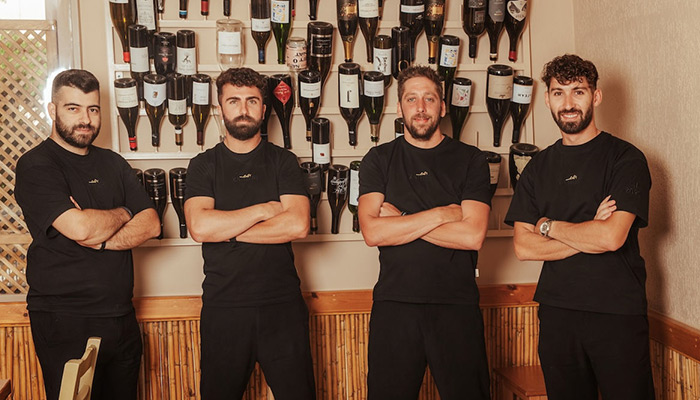
Wine tasting at “Xatheri” from the Efrosini Winery!
March 15, 2024The online website theknife.online did a beautiful feature on our Xatheri entitled “Showcasing Crete: We meet the people revitalising Cretan cuisine”. Thank you very much for your time and support!
‘Authentic Crete country coking is best exemplified by the Xatheri restaurant in Kroustas, a 30-minute drive into the mountain above the Minos Arts. Its specialties include goat spaghetto, stuffed zucchini flowers, pork souvlaki skewers, and gamopilafo wedding rice with skaka clarified butter.
“We love snails in Crete and cook them in many ways,” says owner Konstantinos Markakis, who personally oversees the menu. The cooking is done by his parents Maria Varda and Manolis Markakis.
“A popular dish is chochlioi boubourist. The snails are pan-fried face down with olive oil, rosemary and vinegar. Boiled wild greens often add the finishing touch. We use a lot of dittany or Crete mint, too. We call it “erontes”. Boureki is a speciality of Chania, consisting of layers of potatoes, courgettes (or pumpkin in winter months), myzithra and mint.
“Our traditional pasta is skioufichta makarounia. Flour and water are bound, kneaded and rolled into long, thin sausage shapes. They are then cut, rolled into thumb-sized curls and boiled in salted water, and served with juta staka (clarified butter) and grated kefalotyri or anthotyro cheese. Xinohondros (fermented cracked wheat with sour milk or yoghurt, made into a soup) is one of the oldest ways of preserving milk and was once a staple village meal. Mkserotigana are spirals of thin pastry, gently fried before being soaked in sugar and honey syrup infused with cinnamon and served with chopped walnuts.”
The restaurant has one of the best wine cellars in east Crete. Continues Markakis: “Vilana grape wine is excellent with grilled fish; Greek salads with Cretan graviera and zucchini fritters; Vidiano goes well with rabbit stifado (stew with onions) and lamb with artichokes; Thrapsathiri with grilled octopus, gemista (stuffed vegetables) and white bean soups; and Antikristo goat meat cooked ‘opposite’ the fire is complemented by the spicy, high alcohol Romeiko grape variety.
“As for other red grape wine, Kotsifali pairs with moussaka, lamb and sausage, the tannic Mandilari with smoked pork and the lighter Liatiko with stuffed grape leaves (dolmades), as well as lamb with cinnamon and tomato. Raki is key to Cretan hospitality and culture and great with many things. Ouzo is good with shellfish and to cook shellfish in.”

Wine
Crete’s wines are over 4,000 years old. Kato Zakro is said to be the oldest vineyard in Europe. One of the first great centres of maritime wines trading was Tyros. A popular tourist attraction on the Med’s fifth largest island is the ancient wine press of Vathipetro.
The Phoenicians, Minoans and Romans were all Cretan wine fans and distributors. An amphora found in Pompeii had CRET EXC inscribed on it, meaning “Exceptional Cretan Wine.” Cretan winemaking thrived under Venetian rule. Crete (Candia) built up a reputation for fine wines. That stopped under the Ottomans and production was further loused up by phylloxera and decreased further with mass tourism.
But Cretan wine – the original Tuscany in some people’s books – is making Dionysus, the son of Zeus and bringer of wine, proud again. It offers a suite of great wine choices at bargain prices. The vineyards near the capital Heraklion, comprise Greece’s second largest wine area.
Crete has a variety of indigenous grapes, such as the bay-led Dafni grape, the plummy Kotsifal (similar to Cretan Merlot represented by PDO Peza and Archanes), Mantilari, Muscat of Spino (used to make the sweet Maza), the lemony Plyto, the apricotty white Vilano, and Romeiko. Thrapsathatis, known as Greece’s Viognier, may be difficult to pronounce but is easy to enjoy. The main wine regions in Crete include Dafnes (known for Liatiko reds), Archanes (red Kotsifali and Mandilari), and Peza (white Vilana and red Kotsifali and Mandilari). The PDO of Sitia is home to the Toplou monastery, renowned for its excellent Thrapsathiri-Vilan and Liatiko-Mandilari 2013.
The Millarakis family winery, established in 1932, produces the Minos Wines Red du Crete, a blend of Kotsifali and Mandilari. Other notable producers are Diamantakis in Kato Assites, Douloufkis, and Silva (offering Moschato Spinas Psithiros, meaning ‘whisper’).

Domain Paterianakis leads wine tourism efforts. Their rosé, made with Kotsifali and Syrah, is highly regarded. Manousakis Winery, under its Nostos label, presents Rhone-styled wines. Klados Vidiano is produced in Rethymno, the coastal city between Heraklion and Hania where the variety originated. The nearby Armi vineyard, located at the top of Mount Ida (Psiloriti), produces excellent Thrapsathiri. Lyrarakis, a top producer, offers various wines, including the Golden Malvasia of Crete. In Kato Assites, Diamontakis’s Diamentpetra – a white blend of Vidiano and Assyrtiko – was named Wine of the Year in 2020 by Decanter magazine. The Plakoura Vineyard is known for its definitive Mandilari, considered Crete’s finest red grape with Byzantine notes and an enticing incense bouquet.
Cretan chefs often praise Cretan wines, many of which have Protected Designation of Origin (PDO) status.
Source: https://www.theknife.online/post/showcasing-crete-we-meet-the-people-revitalising-cretan-cuisine



